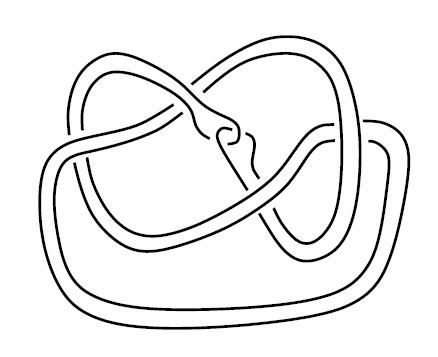 | ||
In the mathematical theory of knots, a satellite knot is a knot that contains an incompressible, non boundary-parallel torus in its complement. Every knot is either hyperbolic, a torus, or a satellite knot. The class of satellite knots include composite knots, cable knots and Whitehead doubles. (See Basic families, below for definitions of the last two classes.) A satellite link is one that orbits a companion knot K in the sense that it lies inside a regular neighborhood of the companion.
Contents
A satellite knot
This means there is a non-trivial embedding
Since
A convention: people usually demand that the embedding
Basic families
When
If
If the link
Examples
Example 1: The connect-sum of a figure-8 knot and trefoil.
Example 2: Untwisted Whitehead double of a figure-8.
Example 3: Cable of a connect-sum.
Example 4: Cable of trefoil.
Examples 5 and 6 are variants on the same construction. They both have two non-parallel, non-boundary-parallel incompressible tori in their complements, splitting the complement into the union of three manifolds. In Example 5 those manifolds are: the Borromean rings complement, trefoil complement and figure-8 complement. In Example 6 the figure-8 complement is replaced by another trefoil complement.
Origins
In 1949 Horst Schubert proved that every oriented knot in
Follow-up work
Schubert's demonstration that incompressible tori play a major role in knot theory was one several early insights leading to the unification of 3-manifold theory and knot theory. It attracted Waldhausen's attention, who later used incompressible surfaces to show that a large class of 3-manifolds are homeomorphic if and only if their fundamental groups are isomorphic. Waldhausen conjectured what is now the Jaco–Shalen–Johannson-decomposition of 3-manifolds, which is a decomposition of 3-manifolds along spheres and incompressible tori. This later became a major ingredient in the development of geometrization, which can be seen as a partial-classification of 3-dimensional manifolds. The ramifications for knot theory were first described in the long-unpublished manuscript of Bonahon and Siebenmann.
Uniqueness of satellite decomposition
In Knoten und Vollringe, Schubert proved that in some cases, there is essentially a unique way to express a knot as a satellite. But there are also many known examples where the decomposition is not unique. With a suitably enhanced notion of satellite operation called splicing, the JSJ decomposition gives a proper uniqueness theorem for satellite knots.
